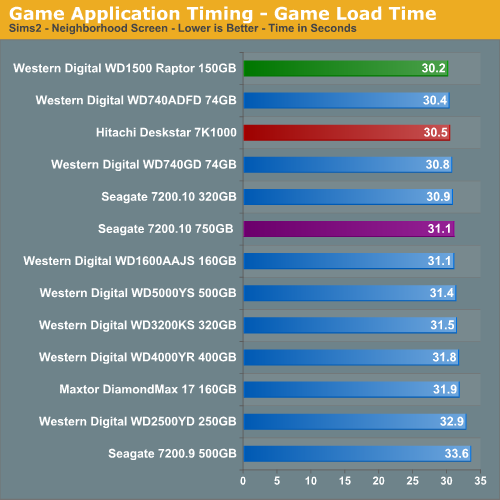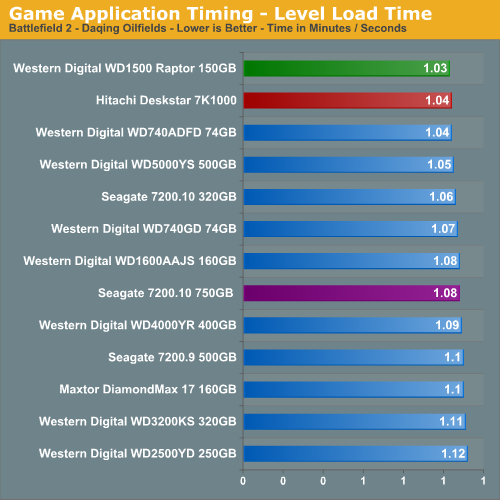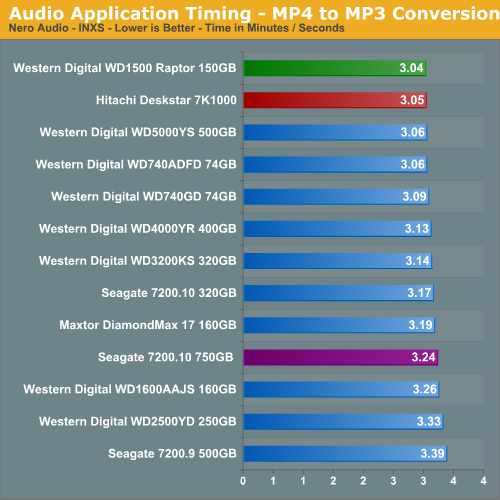Hitachi Deskstar 7K1000: Terabyte Storage arrives on the Desktop
by Gary Key on March 19, 2007 8:00 AM EST- Posted in
- Storage
Actual Application Performance
Our application benchmarks are designed to show application performance results with times being reported in minutes / seconds or seconds only, with lower scores being better. Our graph engine does not allow for a time format such a 1:05 (one minute, five seconds) so this time value will be represented as 1.05. While these tests will show some differences between the drives it is important to understand we are no longer measuring the pure performance of the hard drive but how well our platform performs with each individual drive. The performance of a hard drive is an integral part of the computer platform but other factors such as memory, CPU, core logic, and even driver choice can play a major role in determining how well the hard drive performs in any given task. Also worth noting is that new features of Windows Vista - specifically SuperFetch - can further reduce the measured performance differences between hard drives.
Game Load Test
Our Sims 2 - Open for Business test measures the time it takes to load the initial portion of the game. Our application timer starts when the game icon is initiated until the neighborhood menu appears.

The results are basically the same as our IPEAK results as the WD Raptor series continues to lead all drives although the performance differences are not as drastic once we take into account the entire platform. We notice the Hitachi drive scoring better than the other 7200rpm drives and the drive seemed just as fast as the Raptors over the course of game play, something we generally did not find with our other top performing 7200rpm drives.
Game Level Load
This test centers on the actual loading of a playable level within our game selections. We run Battlefield 2 and measure the time it takes to load the Daqing Oilfields level. Our application timer begins when the start single player icon is initiated and ends when the join game icon is visible.

The WD1500ADFD Raptor continues its pattern of being the best available drive for the gaming enthusiast and our subjective opinion also matches the test scores although we are openly debating this statement now. Of course it is easy to debate our continued love affair with the Raptor as the difference in load times between the WD1500 and the 7K1000 drive was only one second so it appears we are getting close to finally having a Raptor killer in the large capacity 7200rpm drives. We firmly believe the areal density and 32 MB cache advantages of the Hitachi 7K1000 make up for the rotational and random access advantages of the Raptor in our gaming tests.
AnyDVD 5.9.6
Our next test has us utilizing the "ripping" function of AnyDVD to copy the Office Space DVD file from our source drive to our test drive. Our DVD features 29 files totaling 7.55GB of data and is an excellent test for determining the write speed of a drive.

Our Seagate Barracuda 7200.10 320GB drive scores extremely well in this test due to exceptional read times with large data blocks in sequential order, something its larger sibling does not handle well. This is one of the few tests where our 7K1000 does not finish ahead of the other 7200rpm drives but it does improve upon its performance when compared to the IPEAK results. The 7K1000 still manages a top five finish while finishing 15 seconds ahead of the Seagate 750GB drive.
Nero Audio Encode
Our last test has us utilizing the audio encoding functions of Nero to convert our INXS Greatest Hits audio files in MP4 format to a high quality variable rate MP3 file for our portable player. Our test features 16 files totaling 137MB of data and is an excellent test for determining the read and write speed of a drive.

The test results show once again the amount of time a fast hard drive like the WD Raptor can save over the course of audio or video file manipulation session. In this case, the WD1500ADFD finishes just ahead of the 7K1000 where it handles small block sizes in sequential order slightly better due to is rotational speed advantage.
Our application benchmarks are designed to show application performance results with times being reported in minutes / seconds or seconds only, with lower scores being better. Our graph engine does not allow for a time format such a 1:05 (one minute, five seconds) so this time value will be represented as 1.05. While these tests will show some differences between the drives it is important to understand we are no longer measuring the pure performance of the hard drive but how well our platform performs with each individual drive. The performance of a hard drive is an integral part of the computer platform but other factors such as memory, CPU, core logic, and even driver choice can play a major role in determining how well the hard drive performs in any given task. Also worth noting is that new features of Windows Vista - specifically SuperFetch - can further reduce the measured performance differences between hard drives.
Game Load Test
Our Sims 2 - Open for Business test measures the time it takes to load the initial portion of the game. Our application timer starts when the game icon is initiated until the neighborhood menu appears.

The results are basically the same as our IPEAK results as the WD Raptor series continues to lead all drives although the performance differences are not as drastic once we take into account the entire platform. We notice the Hitachi drive scoring better than the other 7200rpm drives and the drive seemed just as fast as the Raptors over the course of game play, something we generally did not find with our other top performing 7200rpm drives.
Game Level Load
This test centers on the actual loading of a playable level within our game selections. We run Battlefield 2 and measure the time it takes to load the Daqing Oilfields level. Our application timer begins when the start single player icon is initiated and ends when the join game icon is visible.

The WD1500ADFD Raptor continues its pattern of being the best available drive for the gaming enthusiast and our subjective opinion also matches the test scores although we are openly debating this statement now. Of course it is easy to debate our continued love affair with the Raptor as the difference in load times between the WD1500 and the 7K1000 drive was only one second so it appears we are getting close to finally having a Raptor killer in the large capacity 7200rpm drives. We firmly believe the areal density and 32 MB cache advantages of the Hitachi 7K1000 make up for the rotational and random access advantages of the Raptor in our gaming tests.
AnyDVD 5.9.6
Our next test has us utilizing the "ripping" function of AnyDVD to copy the Office Space DVD file from our source drive to our test drive. Our DVD features 29 files totaling 7.55GB of data and is an excellent test for determining the write speed of a drive.

Our Seagate Barracuda 7200.10 320GB drive scores extremely well in this test due to exceptional read times with large data blocks in sequential order, something its larger sibling does not handle well. This is one of the few tests where our 7K1000 does not finish ahead of the other 7200rpm drives but it does improve upon its performance when compared to the IPEAK results. The 7K1000 still manages a top five finish while finishing 15 seconds ahead of the Seagate 750GB drive.
Nero Audio Encode
Our last test has us utilizing the audio encoding functions of Nero to convert our INXS Greatest Hits audio files in MP4 format to a high quality variable rate MP3 file for our portable player. Our test features 16 files totaling 137MB of data and is an excellent test for determining the read and write speed of a drive.

The test results show once again the amount of time a fast hard drive like the WD Raptor can save over the course of audio or video file manipulation session. In this case, the WD1500ADFD finishes just ahead of the 7K1000 where it handles small block sizes in sequential order slightly better due to is rotational speed advantage.










74 Comments
View All Comments
phusg - Tuesday, March 20, 2007 - link
I think you are right, but don't forget that in this post you are only looking at it from a performance viewpoint. Drive longevity and acoustics are major factors to me, and I think for you too from the article. I think these are the metrics worth looking at and tend to agree that subjective performance doesn't really differentiate that much (although I haven't had half as much experience with different vendors/models as you have).gramboh - Monday, March 19, 2007 - link
I read the review earlier this morning but don't recall seeing anything about retail channel availability. Did Hitachi or Dell comment to AT about this?I'm actually interested in 500GB 7200.10's and hoping this release will push the price of those down a lot.
Gary Key - Monday, March 19, 2007 - link
We do not have an exact date. Hitachi committed to having product into the retail channel by the end of Q1. We should have an answer from Dell tomorrow on when they will offer it outside of their systems. Hitachi is saying the drive will launch at $399, just waiting to see $550 price tags when the first drives show up... ;)Jeff7181 - Monday, March 19, 2007 - link
This might find it's way into my computer later this year. :)BUL - Monday, March 19, 2007 - link
Interesting that perpendicular technology was chosen given the R&D costs (with the tiny return of ~5 years before obsolescence--the article mentions that perpendicular can ONLY go 5x denser with existing techology & figure we'll see 5TB perpendicular drives in 2 years), etc... So why don't manufacturers offer 5 1/4" drives? Not to invoke memories of the MFM drives of long-ago (the original XT had a double-size 5 1/4" MFM drive of 10MB), but they have potentially 50-60% more surface area per platter, and with a possibility of 7(?) platters, isn't that a better solution? True, you wouldn't put them in SFFs or notebooks, but how many of us have towers with empty 5 1/4" bays??? And I assume that a 1TB 5 1/4" drive would be more energy-efficient than two 500GB 3 1/2" drives...Also, has anyone REALLY tested to see if perpendicular is truly a reliable technology? Seems like manufacturers have 50 years of experience with parallel storage, and only 1-2 years using perpendicular storage...
Spoelie - Tuesday, March 20, 2007 - link
Bulkier, slower, less energy efficient and more moving parts that reduce reliability all in the name of increased capacity is not the way to the future. I think the biggest problem at the moment is NOT storage capacity, they're mostly increasing capacity to keep HDs evolving and not drop in price, as it's one of the only competitive advantages. If you can increase capacity with the same material cost and some extra R&D, it would be stupid not to do it, and a better way than increasing the material cost.In fact, regular folk have way too much capacity at the moment. A Seagate CEO worded it nicely a while back "Face it, we're not changing the world. All we do is enable people to store more crap/porn."
The future lies in the direction of flash based hard drives: smaller, less/no moving parts instead of more, faster access times, lower energy consumption/heat. Or other alternative technologies that offer the same advantages. The densities and cost are the only reasons we're not all buying them at the moment, something that should be fixed over time.
If you're worried about unused case slots, buy one of those things that enable you to install normal hard drives in it, or convince the case designers to include more 3 1/2" slots and less 5 1/4" slots.
misuspita - Monday, March 19, 2007 - link
Have you ever seen a slow motion filming of a cd-rom disk wobbling? Same thing here! I think the platters got smaller because the vibrations produced by them grew with the speed. Since today's r/w heads need to be extremely close to the surface, that would be utterly impossible to control at that speed and diameter. They changed also from an aluminum based disk to an glass based one also, because the roughness of the surface on the Al platter.tygrus - Monday, March 19, 2007 - link
It's harder to spin a large diametter platter at high speed. More weight, more wobble, slower access times. I saw once a 5.25" 4x2.5" SATA drive array. Quantum used to do a large format BigFoot for cheap, slow large capacity but it wasn't continued. We have plenty of capacity per platter but limited perf/GB (worse every year) so why decrease performance to increase capacity ?piroroadkill - Monday, March 19, 2007 - link
All of the Seagate Barracuda 7200.10 drives have been perpendicular for some time..It seems like a perfectly reliable tech to me
Olaf van der Spek - Monday, March 19, 2007 - link
How smart is it to use temperatures from SMART?Did you verify all HDDs use good quality unbiased temperature sensors?
> Our thermal tests utilize sensor readings via the S.M.A.R.T. (Self-Monitoring, Analysis and Reporting Technology) capability of the drives and are reported by utilizing the Active SMART 2.42 utility.